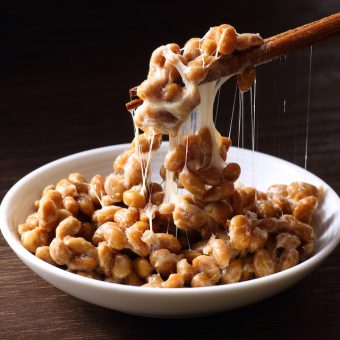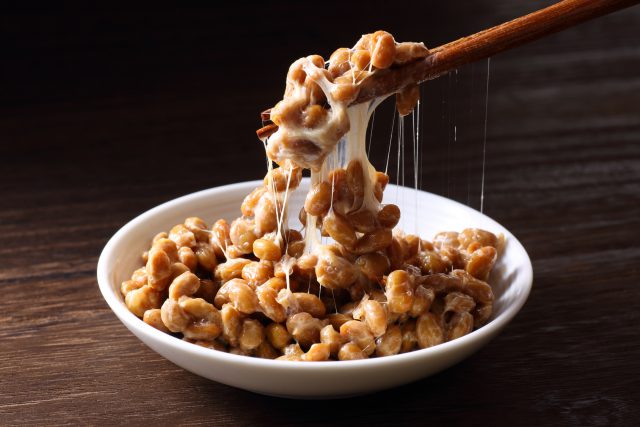
NATTO (fermented soybeans)
Highly recommended “must-have” item when you go on a trip
Regular consumers of natto rarely get their stomach upset, because the bacteria in fermented soybeans is stronger than coliform. This is why dry natto (sold on the market) is highly recommended as a bring-along item for those going on a trip to places where they will be introduced to different unaccustomed types of food.
Effect on health and beauty:
・Skin roughness, blemishes/freckles: Many people tend to think vitamin C is good for their skin, but its effect on the skin cannot be fully appreciated unless vitamin B2 is consumed together.
・Menstrual cramp , menstrual disorder: Natto also contains lots of minerals. Among them, zinc is especially effective in releasing female hormones. Collagen generated together with vitamin C is also effective in preventing skin roughness and blemishes/freckles.
・Osteoporosis: To make your bones strong, calcium and vitamin K that is effective in keeping calcium in your bones are both necessary. Natto contains both of them.
Overview:
・Natto is one of the most representative food item that goes very well together with rice, and is widely considered the “king of fermented food” among the Japanese.
・Bacteria in natto decomposes protein and increases the viscosity.
・It is highly nutritious. It comes in the 7th place in the world’s ranking of food with strong odor (according to the research by Dr. Takeo Koizumi).
・Natto is largely divided into two types: stringy natto and briny natto. Briny natto was the initial type that was introduced to Japan from China. The Japanese then developed its own method of production and originated the stringy type of natto.
Characteristics:
・In terms of calories, there is 200kcal for 100g of natto. It is greater than the calorie of boiled soybeans (180kcal/100g) and approximately triple that of tofu (soybean curd).
・Soybean contains 16-17g of protein per 100g, which is equivalent to beef. But the amount of lipid is limited to 1/2 – 1/3 of beef, and it is almost cholesterol-free.
Major area of production:
Japan
Nutrients:
Protein, potassium, vitamins B2 and K, folic acid and magnesium

